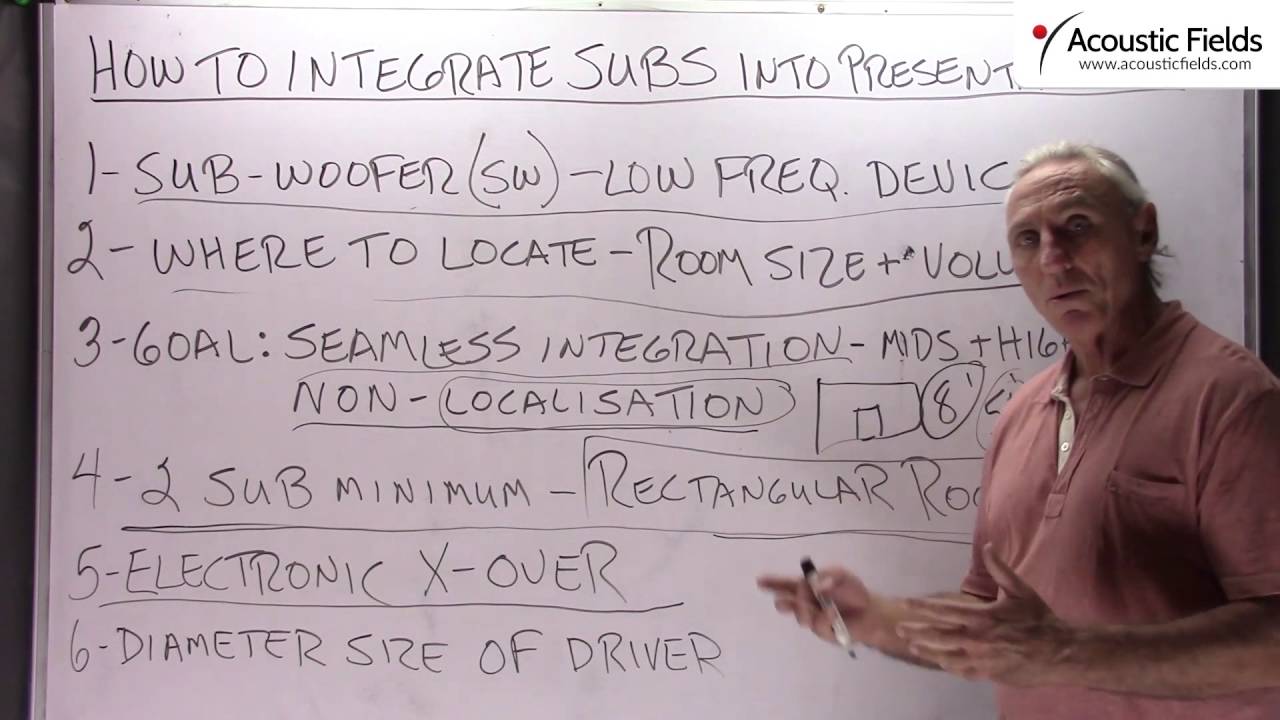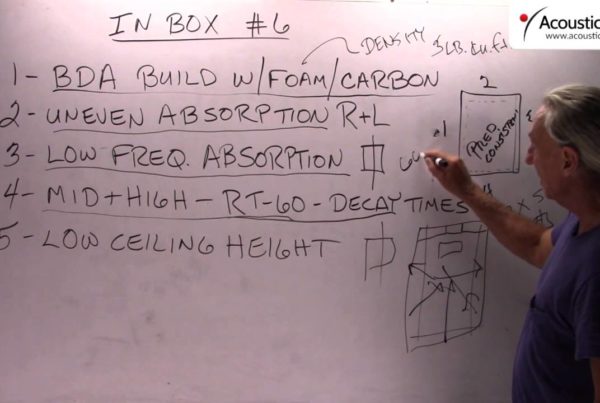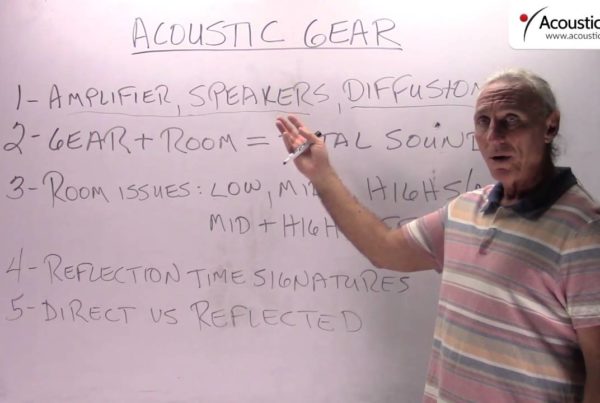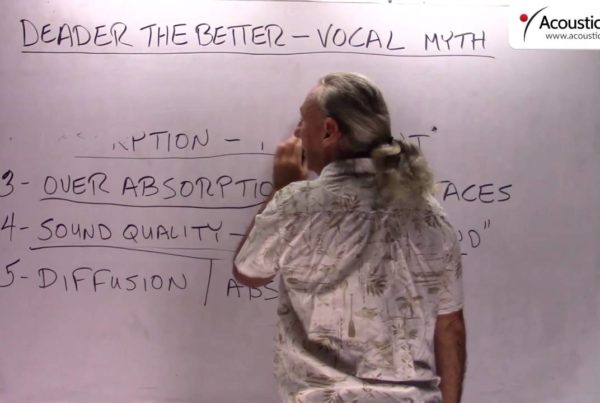Today we’re going to talk about how to integrate subs into your presentation, into your room whether it’s home theater, control, mixing, two channel playback, it really doesn’t matter.
Let’s look at what a low frequency producing device called a sub-woofer is and that’s exactly what it is. Forget that it’s a speaker, forget about attack and decay and definition. Realize that this is a huge, low frequency producing device that your room will not like. At least mostl small rooms that we work with.
So you’re already going uphill so to speak in the integration side of things with sub-woofers. People don’t take this serious enough and their rooms are just overwhelmed with low frequency energy to the point you can’t hear where the lows start, the mids begin, the highs… it’s all just a jumbled mess.
So start thinking about your – so before as a low frequency producing device that the room does not want, it’s going to do everything in its power so to speak to get rid of it. It’s going to make noise, it’s going to exhibit room modes, it’s going to smear and blur everything, if you don’t integrate it correctly. So you have to be very, very careful here.
So let’s step back a little bit. Don’t think of it as a speaker because speakers by definition most of us have used our whole lives and they don’t work well in rooms, they were designed to do that but sub-woofers not so much. So we have to define what they really are which is a low frequency energy-producing device that the room won’t like, okay?
So knowing those parameters how we’re going to locate this thing? Where are we going to locate it? Well, in today’s rooms with our 8 foot ceiling heights we don’t put a sub-woofer that produces energy that’s 50 to 55 foot long at its lowest points in an 8 foot dimension. Does that sound right to you? Well, it shouldn’t. So you’re going to have all kinds of problems. Here’s a good rule of thumb. You’ve got an 8 foot dimension and a 50 foot long wave, okay? So you’re going to have 6 times the problems. It’s a good way to kind of think about it.
So what is our goal with subs? Seamless integration. We don’t want to know where they are in the room, we want to just experience and feel the low end that’s defined and separated and has good attack and decay. We don’t want to know where it’s coming from. We don’t want to know that the sub-woofer is over here, the sub-woofer is over there because it’s not a speaker. It’s a low frequency generating device. So we want to make sure a low frequency energy is distributed evenly throughout the room. We don’t know where it’s coming from and it integrates well and it plays well with our other frequency. So we’ve got to do that.
Here’s what we’ve been finding over the last couple years and dealing in small rooms and doing all kinds of design work in small rooms that you really need a two subminimum. Two subs produce enough energy that you can get non-localization and a seamless integration. We find with one the localization is a lot easier. So we like to use two low frequency producing devices in most of our rooms. That said, you know you have to have the right size and you have to have the right volume.
So we work a lot in rectangular rooms because they’re predictable and consistent so we like to use a two subminimum. What kind of sub? What manufacture? You choose. We couldn’t care less. Neither can your room. It doesn’t care who made it. It only cares that it’s a low frequency energy-producing device that obviously won’t fit very well.
So a must have is an electronic crossover because with today’s recording some have a lot of low ends, some don’t have any because of the room in which they were mixed and mastered in. So there’s no consistency in our recorded material. So with electronic crossover you can take a recording that doesn’t have a lot of low frequency energy and you can add some, okay? You can add some through the crossover. You can crossover what frequencies you sent to the sub-woofer so that’s more compatible with your room size and volume and get a lot better blending non-localization and an integration with an electronic crossover. So we use electronic crossovers on all our subs, we use a two sub minimum in most rooms.
So the diameter of driver you use in the sub is also important because you’re going to have a room, it’s going to have a certain size, okay? It’s going to have a certain height, it’s going to have a certain length and it’s going to have a certain width, okay? So you’re going to have all kinds of problems with a small room. So you’re going to have low frequency issues, you’re going to have things like that. You’re going to have bumps in the low end and you have to realize that a 10 inch driver versus a 12 inch driver there’s a plus 2DV gain differential.
So whatever problems were exhibiting that are untreated in a room we have to be careful about adding another 2DV of energy by picking a driver size that’s too big for the room volume. So we don’t want to exaggerate remember, the first rule of acoustics is do no harm so we don’t want to do any harm here. We have to be very careful with our driver diameter selection. Everything has to integrate, everything has to fit. And just remember that you’re putting a device in the room that the room doesn’t want to be there. So you have to spend a lot of time and care evaluating the proper place to put it.
—
This is an unedited transcript from our video series from Acoustic Fields. There will be some errors in grammar and sentence structure that occur during this translation process.
For complete understanding and comprehension, please view the video which is included in this text. For any additional information regarding this topic or others relating to room acoustics, please contact us directly at:
P: 520 – 392 – 9486








The discussion on ductwork noise transmission from Acoustic Fields highlights crucial aspects of HVAC system acoustics. The movement of air…
Great build plans. thank you Denis
You must use absorption. Never place a chair against a wall.
A friend and I built several diffusors using these plans and they turned out absolutely beautiful. Very good instructions and…